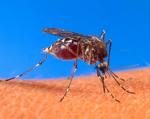‘No. 1 Haryana’ Campaign Hit Hard By Mosquitoes
The ‘No. 1 Haryana’ campaign, which is currently being aired on cable networks  across the state, is likely to be hit hard by the threat due to a potential enemy – mosquitoes. Following the recent cases of dengue and cholera, malaria too has joined the ‘league’ with over 28,000 confirmed cases recorded of late from different places throughout the state.
across the state, is likely to be hit hard by the threat due to a potential enemy – mosquitoes. Following the recent cases of dengue and cholera, malaria too has joined the ‘league’ with over 28,000 confirmed cases recorded of late from different places throughout the state.
This high number of confirmed cases has surpassed the figure of 23,278 cases, recorded in Uttar Pradesh. Despite this, the health department, still asserts that this outbreak is yet to take the shape of an epidemic.
Going by the statistics, Hisar tops the table with 6,100 confirmed cases. Others that follow are: Jind (5,307 cases), Karnal (4,756), Fatehabad (2,302), Bhiwani (1,954), Sirsa (1,110), Kaithal (1,585), Rohtak (973) Panipat (847) Sonepat (787) and Yamunanagar (595). The areas account for for majority of the cases.
Talking about dengue cases, the Director General of Health Services, Haryana, Dr Avinash Sharma said: “This year so far, 649 people in different age groups have tested positive for dengue. Two people have died in Gurgaon, three in Sonepat, two in Rohtak and one in Jhajjar.” She also said that nearly 380 cases of dengue have been reported from Gurgaon alone, where a health team from National Institute of Virology is expected to pay a visit soon.
In addition to dengue and malaria, four cases of ‘chikungunya’ have also been reported from different places in Haryana during this monsoon season.
The underlying causes of all these diseases are, by and large the same old ones – namely, unhygienic conditions and contaminated water. In addition to these, the problems of people residing in rural areas are aggravated due to the absence of regular power supply, leading to increase in the number of fatal cases.
Dr Sharma said that to combat the problem, the health department was taking steps to prevent breeding of mosquitoes around inhabited areas. This was being done with methods like indoor fogging and applying insecticide in households. Moreover, the department had also been sending its teams to areas where Annual Parasitic Index exceeds 5, (i.e.areas in which five or more people test positive for malaria in a population of 1,000.)
Dr Sharma said, “All precautions have been taken and our teams are continuously monitoring the affected areas. Though the number has exceeded the one recorded last year, it is quite less as compared to other states.”